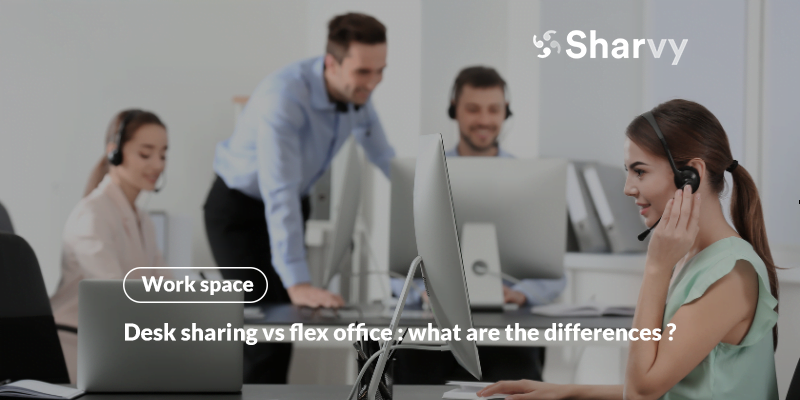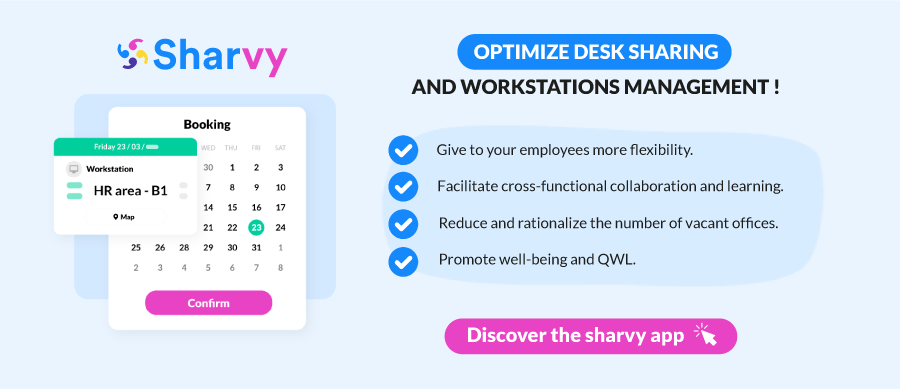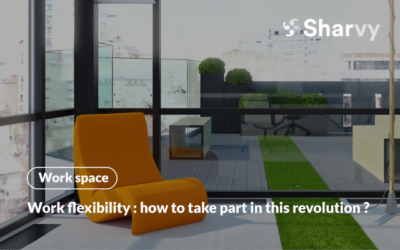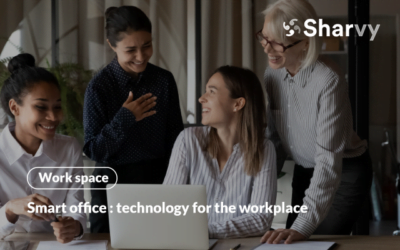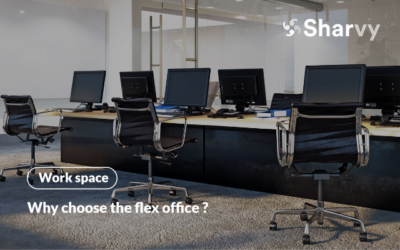In a constantly changing world of work and faced with the economic and social consequences of the Covid-19 crisis, we can see that new organizational methods are taking hold within companies. In particular : flex-office and desk sharing.
Two very different terms, but they are still confused by many people. Indeed, if both reflect new work environments in companies, they are the logical consequence of the fragmentation of professional uses and increased work flexibility.
However, they are not synonymous. So, in this article : focus on the main differences between flex office & desk sharing! As a bonus, we’ll help you choose the mode of operation that suits you and give you five valuable tips to keep in mind.
Flex-office & desk sharing : a reminder of their meteoric rise!
In recent years, due to the increase in property prices, and the massive use of teleworking, combined with the consequences of the Covid-19 crisis, many companies are looking to rethink their work organization.
At the same time, it is not a secret that many jobs no longer require a physical presence in the office. This is true, as long as the employee has a computer and an Internet connection. As a result, and with the increase in teleworking, there has been a drastic fall in the occupancy rate of workplaces. This leaves companies in a difficult situation : they pay a high price for many vacant offices.
Given this, the traditional work organization where employees have the same workspace all year round is gradually becoming obsolete.
This is why many companies want to redistribute the space they have available. This is no longer based on people but on usage. In this respect, they offer employees the freedom and convenience to choose the workspace in which they are most productive, depending on their mood and their tasks.
As a result, new forms of work organisation are emerging, such as hot desking, corporate corpoworking spaces, flex-office and desk sharing. Two terms to be distinguished.
How could you distinguish between flex-office and desk sharing? A reminder of definitions & explanations!
Flex-office and desk-sharing are new forms of organization, meaning that workstations are no longer rigidly distributed among employees. However, a distinction should be made :
Flex-office (or flex desk) means no longer allocating a specific workstation to an employee. As a result, the company sets up different types of spaces that employees can use freely, according to their desires, missions, and projects. In this type of organization, we often find accessible offices, meeting rooms, concentration areas with acoustic booths, coworking rooms, etc. For example, in a flex office environment, employees might start their day in a collaborative workspace for team meetings and then move to a phonebox in the afternoon for quiet work. This flexibility allows them to choose the most suitable work location for their current needs, thereby improving their quality of work life. Sometimes these spaces are also open to the reservation, so each employee can easily anticipate their week. At the same time, employees can also choose to work from home at a pace agreed upon with their manager.
Desk sharing consists of sharing the same space or fixed office between several company employees. It is generally carried out between employees of the same team to encourage exchanges on familiar subjects directly from their workstations. For instance, in a desk sharing setup, team members share desks, which makes collaborative work easier and encourages exchanges on joint projects. This approach maintains team cohesion while maximizing the use of office space. Therefore, it regularly has the same characteristics as the open-space format. And finally, this concept allows everyone to keep their bearings while stimulating creativity and collaboration. So it’s a great way to strengthen team spirit & avoid individual offices, which are sometimes too far away from other employees.
From then on, and for these two anglicisms, we can see that the individual office is coming to an end in favor of a collaborative dynamic, accompanied by greater openness & hybrid working.
How to choose your operating mode : flex-office vs desk sharing?
There is no doubt that the challenge for employers and/or managers today is finding the formula that best suits the company and its employees. This is achieved by proposing an organization and appropriate & stimulating arrangements that benefit employees’ well-being and Quality of Life & Working Conditions (QWL).
Not an easy task, is it? To help you, let’s distinguish the points to keep in mind for each operating mode.
1st operating mode : flex-office. Preferable if :
- Employees do not see it as a form of dispossession of their workspace. Remember that any form of personalization (drawings & photos of one’s child, mug, and files) becomes impossible by opting for the flex office. Therefore, it should appear to them as something other than a sudden nomadism.
- Employees (really) play the flex-office game and sometimes settle in different places. If this is the case, they can prevent the compartmentalization & diversification of links within the teams.
- On a day-to-day basis, it is not a frantic race for the best place! The flex office indeed obeys the adage that first come, first served. And unfortunately, the fair distribution of workplaces would take care of itself between adults. However, this is not the case. Therefore, if you don’t have a digital solution dedicated to its management, this organization can produce the opposite effect and creates tensions.
This is why, if it is the organization of work you wish to prioritize, it is essential to put all the chances on your side to avoid friction and make this new organization go well. This can be achieved by choosing a Workplace Management solution such as Sharvy, dedicated to its management and the fair distribution of workstations.
2nd operating mode : desk sharing. To be preferred if :
- Your employees adopt a responsible attitude & respect the community. Desk sharing closely resembles the open-space format. Therefore, make sure that this format suits your employees. But, open spaces are a large mix of more dissipated teams for many people. So, this can be a source of stress & de-concentration that you need to be aware of to reduce this disadvantage (acoustic separation, provision of headphones so as not to disturb your neighbors, etc.).
- Your employees want to keep a minimum of reference points. Unlike the flex office, where some employees can become disoriented at changing offices daily, desk sharing may be more suitable for them. In particular, because it does not involve such a radical change of neighbors and/or workspaces. Consequently, the adjustment time for everyone is also shorter!
- The confidentiality is required between each division. Therefore, desk sharing is a real advantage in terms of privacy. Generally, when desk sharing is chosen, the teams of each division are nearby. As a result, they can quickly deal with more confidential matters specific to their missions.
Five tips for a successful transition to your new work organization!
1. Think about digitizing the exchange methods & work habits beforehand
There is no doubt that the transition from traditional working methods to flex-office and/or desk sharing must be carried out in stages. The idea is to gradually rethink practices by digitizing existing rules while adapting the media and working methods.
Therefore, it is a good idea to introduce various tools beforehand. For example, those allowing to :
- Dematerialise documents, such as Payfit, Lucca, etc.
- Facilitate daily collaboration, such as Notion and Asana.
- Offer instant communication, such as Teams, Slack, Google Chat, etc.
This way, you can keep the environment and work habits the same, especially since the evolution of tools is so rapid that it challenges both the skills of the teams and the company’s digital strategy.
2. Consult customer cases to learn about this & get inspired!
Both flex-office and desk sharing are not just trends but natural evolutions. This is why it is essential to analyze employees’ habits through a diagnostic phase. But also to consider all the specificities linked to certain professions and departments. During this period, please take the time to identify the points that can block the process and the solutions to fix them.
At the same time, this is also the time to learn from other companies. For example, by consulting case studies. This may help you to make confident choices about your company.
To inspire you, here are some examples of companies that have adopted flex-office and/or desk sharing :
- Adidas : On the one hand, to promote internal communication & exchanges within the teams. On the other hand, it is a good way of showing that the company is keeping up with the demands of tomorrow’s world, with innovative and smart workplaces.
- LeBoncoin France : A company that has succeeded in creating a dynamic working environment in which no employee, including administration members, has a dedicated office. This encourages agility and flexibility between teams.
- SNCF : The company wanted to reduce its office space by 22%. Thanks to the implementation of flex-office, the results speak for themselves! The reduction target was reached, and more than 80% of employees were satisfied.
3. Remember to increase the number of collaborative spaces & concentration zones
There’s no doubt that these new working environments (flex-office and desk sharing) are shaking up previously established patterns. Nowadays, employees are required to use different places during their day, depending on their current tasks and projects. For this reason, and to meet these needs, it is essential to offer them various types of spaces and atmospheres.
On the one hand, collaborative spaces encourage exchanges and remove the traditional barriers of individual offices.
On the other hand, areas of concentration. For example, installing acoustic booths, also known as “phone booths” or “focus rooms.” These are nothing more and nothing less than concentration areas where employees can isolate themselves to work. These booths are trendy for production tasks (writing articles, development, etc).
4. Adopt a digital solution for managing shared spaces!
To facilitate this transition, it is wise to digitalize it. To achieve this and best support your employees in this organizational change, you can opt for a web & mobile application dedicated to its management, like Sharvy.
With this application, your employees can easily reserve a workstation to anticipate their attendance schedules and organization over the coming weeks.
At the same time, this solution removes fears about this new organization based on the adage of first come, first served. In particular, since the workstations are allocated automatically, according to a fair algorithm and rules defined in advance by the administrator.
5. Respect a flexible test period & get feedback from your employees
There will always be gaps between theory and practice. This is why a test phase will allow you to highlight the points that need to be improved as a priority based on the feedback from your employees.
According to a study by JLL, a corporate real estate consulting specialist, more than 75% of companies rely on a test period to remove various barriers.
When such a change in the working environment is announced, many companies regularly experience opposition from their employees. Many consider that flex-office and/or desk sharing cannot be adapted to their business constraints or status.
However, by including all or some of your employees from the beginning of the project, you prepare them for a wider deployment. At the same time, you let them know that their opinions and feedback will be considered. This helps to remove prejudices and unfavorable opinions. This is why respecting a somewhat flexible test period is a good idea.
In conclusion
Managing shared space in companies is a challenging task. The difficulties that the departments in charge of this task may encounter can multiply significantly if, from the outset of the project, the boundaries between flex-office and desk sharing are blurred.
However, whether it is one or the other, each has its advantages and disadvantages. However, there is bound to be one that is more in line with your working methods and the habits of your employees. Please look at this article’s tips and significant differences to determine which one it is. After that, the test phase is an excellent way to decide between the two methods.
Have a question ? Check out the FAQ !
How long should the test period last ?
A test period of 3 months is ideal. It allows everyone to start developing new habits and, if so, to get to grips with using a dedicated application. This period also gives the departments in charge of this new organization the opportunity to refine their strategy, given the behavior of employees and those who play the game or not. After three months, it is advisable to implement a wider roll-out so that employees can organize themselves and plan their needs over the longer term.
Is it normal for employees to be reluctant or resistant to change ?
Resistance to change is a perfectly natural behavior! However, the fact that some employees tell you about this resistance is not necessarily an opposition to introducing this new feature but rather a fear of losing their bearings and the work habits they enjoy. This is why these new ways of working require managers’ support and education to overcome apprehensions. However, remember that resistance to change is a positive point insofar as it reveals the importance of the work environment in employees’ eyes! An end to consider in this new strategy.
How can confidentiality be ensured in these working environments (flex office & desk sharing) ?
On the one hand, creating areas dedicated to confidentiality is essential. These areas, equipped with acoustic and visual devices, provide a safe place for confidential discussions, sensitive meetings, or processing personal information.
At the same time, raising employee awareness of confidentiality issues is crucial. Training sessions can be a helpful way of addressing good practice and the need to comply with confidentiality standards, reinforcing an organizational culture focused on data protection.
Finally, the implementation of strict access management policies is another crucial measure. Access to sensitive areas and confidential information must be strictly regulated, using secure identification systems, access cards, or other access control methods. This ensures that only authorized individuals can access these restricted areas.
How can we measure the success of the transition to these new work organisations ?
Measuring the success of the transition to the flex office and desk sharing involves a holistic assessment, combining objective and subjective data.
Firstly, employee satisfaction is a fundamental indicator. Regular surveys on their feelings, comfort level, and perception of the new layout provide crucial subjective data.
Secondly, analysis of organisational performance is essential. Indicators such as productivity, internal collaboration, talent retention and quality of work can be compared before and after the transition to assess the impact of these new work organisations.
Thirdly, cost management and the optimal use of real estate resources are other measurement criteria. Reducing the cost of the workspace, better allocation of resources, and optimized use of workstations are positive indicators of the financial success of the transition.
Finally, the fluidity of operational processes deserves to be assessed. A successful transition should make everyday life easier for employees, by reducing logistical obstacles.
Want to learn more? Check out our latest articles!
Work flexibility : how to take part in this revolution?
Discover the best practices to implement in company, to take the turn of the flexibility of work and improve the QWL.
Smart office : technology for the workplace
The Smart Office is developing rapidly within companies. How is the technology being used in the workplace?
Why choose the flex office?
The flex office is gradually taking hold in companies. What are the advantages of setting up this type of organisation of spaces?
Subscribe to our newsletter!
Resources
Contact us
+44 117 463 6990

